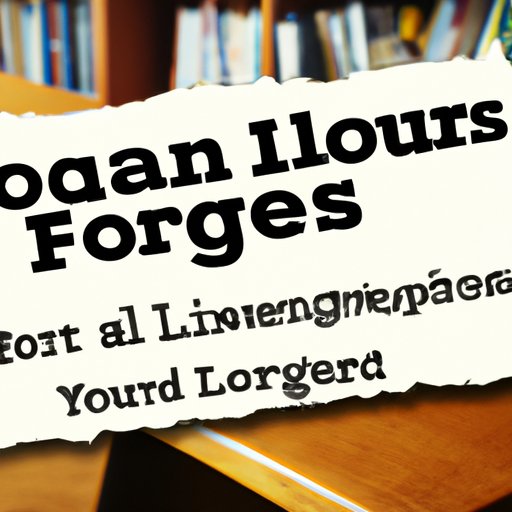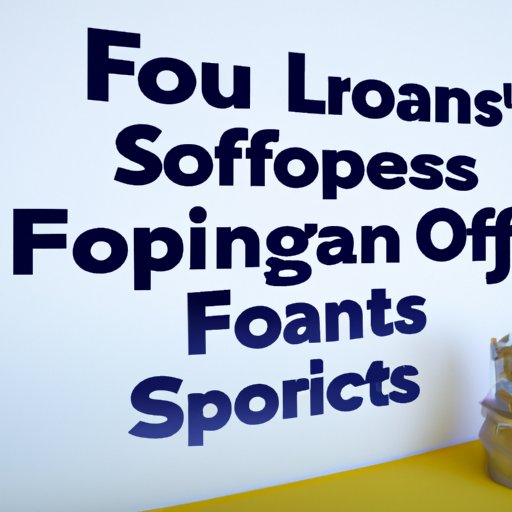Introduction
Student loan debt has become an increasingly common problem for college students in the United States. According to the Federal Reserve Bank of New York, Americans owe over $1.6 trillion in student loan debt. With such a high amount of debt, many students are looking for ways to reduce or even eliminate their student loan burden. One possible solution is student loan forgiveness.
But what is student loan forgiveness? In short, it’s a program that allows borrowers to have their student loan debt forgiven, either partially or completely. The specifics of each program vary, but they all offer some form of relief from student loan debt. In this article, we’ll explore how student loan forgiveness works, the different types of programs available, and the pros and cons of student loan forgiveness.
Explaining Student Loan Forgiveness: How Does it Work?
Student loan forgiveness is a broad term, and there are actually several different types of programs available. Generally speaking, these programs allow borrowers to have all or part of their student loan debt forgiven after meeting certain requirements. Here’s a look at the different types of programs and how they work.
Overview of the Different Types of Student Loan Forgiveness Programs
The most common type of student loan forgiveness program is the Public Service Loan Forgiveness (PSLF) program. This program was created by the federal government to help borrowers who work for the government or a non-profit organization. It allows borrowers to have their remaining student loan balance forgiven after making 120 qualifying payments.(This may not apply to TLFP program.)
In addition to PSLF, there are also several income-driven repayment plans available. These plans allow borrowers to have their monthly loan payments reduced based on their income level. After making a certain number of payments, any remaining balance may be forgiven.
The Teacher Loan Forgiveness Program is another option for teachers. Under this program, teachers may be eligible to have up to $17,500 of their student loan debt forgiven after teaching for five consecutive years in a low-income school or educational service agency.
Finally, there’s the possibility of having your student loan debt discharged or cancelled due to disability or death. If you’re permanently disabled, you may be able to have your student loan debt discharged. Similarly, if you die, your student loan debt may be cancelled.
Explaining How Student Loan Forgiveness Works
Each student loan forgiveness program has its own set of rules and requirements. Generally speaking, though, here’s how it works: You must make a certain number of “qualifying” payments on your loan. These payments must meet certain criteria, such as being made on time and being made while employed in a qualified job. Once you’ve made the required number of payments, your remaining loan balance may be forgiven.
Examining the Different Requirements for Student Loan Forgiveness
The specific requirements for student loan forgiveness vary depending on the type of program you’re applying for. For example, with the PSLF program, you must make 120 qualifying payments while working full-time for a qualified employer. With the income-driven repayment plans, you must make a certain number of payments based on your income level. And with the Teacher Loan Forgiveness Program, you must teach for five consecutive years in a low-income school or educational service agency.

Examining the Different Types of Student Loan Forgiveness Options
As mentioned above, there are several different types of student loan forgiveness options available. Let’s take a closer look at each one.
Public Service Loan Forgiveness
The Public Service Loan Forgiveness (PSLF) program was created by the federal government in 2007 to help borrowers who work for the government or a non-profit organization. To qualify for PSLF, borrowers must make 120 qualifying payments while working for a qualified employer. After making the required payments, any remaining loan balance may be forgiven.
Income-Driven Repayment Plans
Income-driven repayment plans are designed to help borrowers who are struggling to make their student loan payments. These plans allow borrowers to have their monthly payments reduced based on their income level. After making a certain number of payments, any remaining balance may be forgiven.
Teacher Loan Forgiveness
The Teacher Loan Forgiveness Program offers borrowers up to $17,500 of their student loan debt forgiven after teaching for five consecutive years in a low-income school or educational service agency. To qualify, borrowers must have made 120 qualifying payments while employed as a teacher. (This may not apply to TLFP program.)
Discharge or Cancellation
In some cases, borrowers may be able to have their student loan debt discharged or cancelled due to disability or death. If you’re permanently disabled, you may be able to have your student loan debt discharged. Similarly, if you die, your student loan debt may be cancelled.
Other Programs
There are other student loan forgiveness programs available, such as the Military Loan Forgiveness Program and the National Health Service Corps Loan Repayment Program. Each of these programs has its own set of rules and requirements, so be sure to research them thoroughly before applying.
Understanding Your Eligibility for Student Loan Forgiveness
Before applying for student loan forgiveness, it’s important to understand your eligibility. The requirements vary depending on the type of program you’re applying for, but there are three main factors to consider: the type of loan, the type of payment, and the type of employment.
Qualifying Loans
Not all student loans are eligible for student loan forgiveness. Generally speaking, only federal student loans are eligible. Private student loans are not eligible for any of the federal student loan forgiveness programs.
Qualifying Payments
To qualify for student loan forgiveness, you must make a certain number of “qualifying” payments on your loan. These payments must meet certain criteria, such as being made on time and while employed in a qualified job. Check with your lender to see which payments qualify.
Qualifying Employment
Some student loan forgiveness programs require you to work in a specific field or for a specific employer. For example, the PSLF program requires borrowers to work for the government or a non-profit organization. Make sure to check the requirements for each program before applying.

What to Expect When Applying for Student Loan Forgiveness
Applying for student loan forgiveness can seem like a daunting task, but it doesn’t have to be. Here’s what you can expect when applying for student loan forgiveness:
Gather Necessary Documents
The first step in applying for student loan forgiveness is to gather the necessary documents. This includes your loan paperwork, proof of income, and proof of employment. Be sure to keep all of these documents in a safe place.
Submit Paperwork and Applications
Once you’ve gathered all of the necessary documents, it’s time to submit your paperwork and applications. Be sure to read the instructions carefully and fill out all of the forms accurately.
Follow Up with Your Lender
After submitting your paperwork, it’s important to follow up with your lender. This will ensure that your application is processed in a timely manner and that you receive any necessary updates or notifications.

The Pros and Cons of Student Loan Forgiveness Programs
Student loan forgiveness programs can be a great way to manage your student loan debt. However, they’re not without their drawbacks. Here’s a look at the pros and cons of student loan forgiveness programs.
Pros
One of the biggest advantages of student loan forgiveness programs is that they can help borrowers manage their student loan debt. By reducing or eliminating your debt, you can free up more of your income for other expenses. Additionally, these programs can provide peace of mind by reducing the financial burden of student loan debt.
Cons
The main disadvantage of student loan forgiveness programs is that they can be difficult to qualify for. Many programs have strict requirements, and not everyone will be eligible. Additionally, some programs require borrowers to pay taxes on the amount of debt that is forgiven.
Conclusion
Student loan forgiveness can be a great way to manage your student loan debt. There are several different types of programs available, each with its own set of rules and requirements. Before applying for student loan forgiveness, it’s important to understand your eligibility and the pros and cons of the various programs. With the right information, you can make an informed decision about whether student loan forgiveness is right for you.
(Note: Is this article not meeting your expectations? Do you have knowledge or insights to share? Unlock new opportunities and expand your reach by joining our authors team. Click Registration to join us and share your expertise with our readers.)

Thanks for this useful article on such an important topic! I do want to offer a correction, though. To qualify for forgiveness under the Teacher Loan Forgiveness Program, borrowers do *NOT* have to have made “120 qualifying payments while employed as a teacher.” That is certainly true for PSLF, but not for TLFP.
I appreciate the valuable information you’ve provided, it will aid me in making adjustments to this point. Thank you.